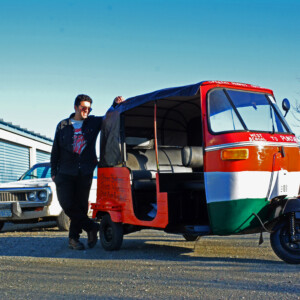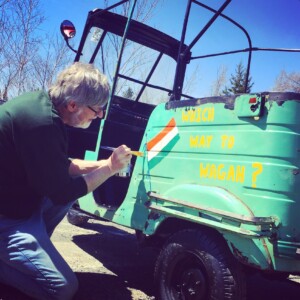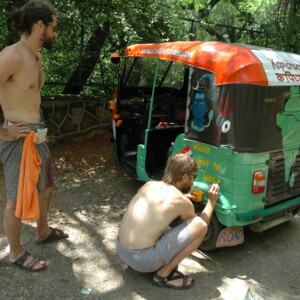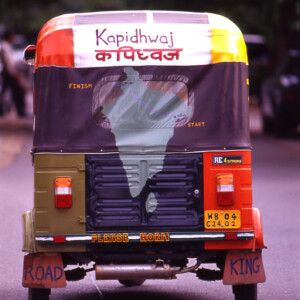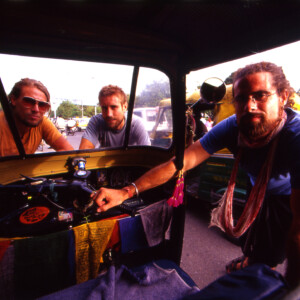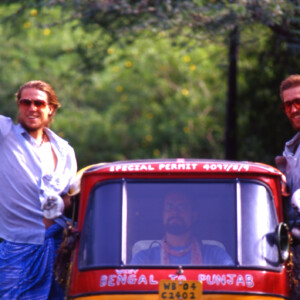The Auto Rickshaw Restoration Project
Three Brothers, Three Wheels, One Rickshaw
The story of the auto rickshaw begins with three CBU Alumni, the Eagar brothers – Jeff, Chris and Steve – and their dream of driving across India on the Grand Trunk Road, from Kolkata to Wagah (on the border of Pakistan) in 2004. Jeff graduated from the University College of Cape Breton (UCCB – now Cape Breton University) with a Bachelor of Business Administration in 1994. Chris and Steve followed, graduating from the Bachelor of Science program in 1995 and 1996, respectively.
The 2600-kilometre journey that the three brothers undertook in the little, three-wheeled vehicle involved risk, heavy costs and discomfort. However, the lure of adventure and discovery was too much for the Eagars to pass up. At great risk to themselves, the brothers set out on their rigorous journey with cameras in hand to record their once-in-a-lifetime road trip. The remarkable journey later became the subject of a documentary aired on the National Geographic Adventure Channel and the Outdoor Life Network.
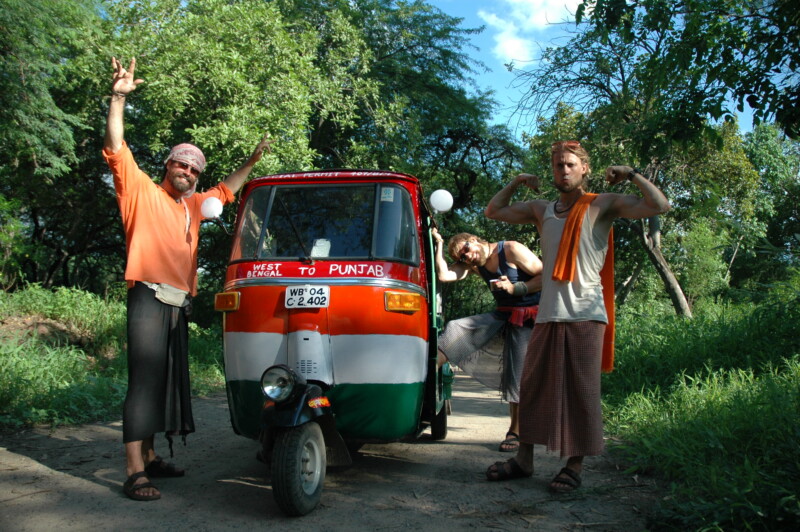
(L-R) The Eagar brothers — Steve, Chris, and Jeff — posing with the auto-rickshaw during their trip in India in 2004.
The auto rickshaw, also known as TukTuk in many parts of the world, is based on Corradino D’Ascanio’s post-war design for a cheap-to-produce, lightweight vehicle for commercial transport. Today, this beloved vehicle model continues to dominate the urban centres of India and South Asia, where it is often seen in the form of bright, colourful and very personalized taxis. Without any doubt, the auto-rickshaw has become a true cultural icon.
The Eagar Brothers’ vehicle, now in the University’s collection, is a two-stroke Bajaj Type 24 which was introduced in 1982 and remained in continuous production until the mid-2000s. In March 2004, the Eagar Brothers purchased their auto rickshaw directly from the Bajaj Auto Rickshaw factory in West Bengal. The purchase alone required a special permit as sales of auto rickshaws were restricted to commercial use only.
Chris Eagar, while waiting for his brothers to arrive, faced challenges obtaining the permit and spent hours in line at the transport office. After a journalist covered his frustration, Chris was contacted by the office to meet with The Honourable Subhas Chakraborty, the Minister of Transport, Sports and Youth Services for West Bengal at the time. Mr. Chakraborty granted the brothers a special letter of permission, allowing them to take the vehicle beyond localized areas and drive across the country.
Inspired by the kindness and encouragement they received during their journey in India, once they had completed the trip, the brothers dedicated to donating their beloved auto rickshaw to the Children’s Charity, Butterflies, a non-governmental organization (NGO) in Delhi. The charity would use the rickshaw as a vehicle to deliver food and aid to many poor children living in the streets of the city. When the brothers returned home and talked to a friend who worked at CBU at the time, Paula MacNeil, former Director of Development, they decided to donate the original auto rickshaw to the University. The brothers then bought a brand new auto rickshaw in India and exchanged it with Butterflies for the old, original one.
As part of CBU’s 50th Anniversary celebration, the Art Gallery has undertaken a project to restore the auto rickshaw and unveil it during Anniversary Week in June 2024. The project, managed by the Gallery’s curator Greg Davies, aims to showcase the vehicle as a permanent art piece to celebrate the Eagar Brothers’ generosity and adventurous spirit, highlight the University’s cultural diversity and bring attention to this unique cultural artifact.
Special thanks to those team members directly affiliated with this special anniversary project including Atharva ‘Doc’ Chohan (lead mechanic), Rachel Anzalone (Gallery and Collections Technician, CBU Art Gallery) and Ian Conn (Restoration Videographer). Our thanks also to Blair Coleski (Sydney Mines) for his assistance with the engine and mechanical repairs during the early stages of the project.
To stay up to date on the 50th celebration, visit CBU.ca/50.

